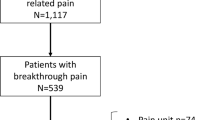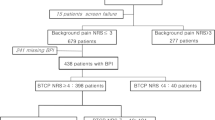Abstract
Purpose
Cancer-induced bone pain (CIBP) is the commonest cause of pain in patients with cancer. Its association with increased morbidity combined with limitations of currently available therapies makes it a clinical challenge. Clinical characterization of this complex pain syndrome is essential in underpinning clinical management and informing future research. The aim of this exploratory study was to characterise CIBP using self-rating scales.
Patients and methods
A cross-sectional survey of patients with CIBP was carried out in a regional oncology centre. Patients described their pain over the preceding 24 h using the McGill Pain Questionnaire, Brief Pain Inventory (BPI), and a breakthrough pain questionnaire. Multiple linear regression analyses were conducted.
Results
Fifty-five patients were recruited. Annoying, gnawing, aching, and nagging were the most commonly used words to describe CIBP. From the BPI, median average pain was 4/10 and worst pain was 7/10 on a 0–10 Numerical Rating Scale. The worst pain score correlated more strongly with BPI interference score (p = 0.001). Forty-one patients had breakthrough pain. Patients with breakthrough pain had higher total BPI interference scores than those with no breakthrough pain; median (IQR); 35.0 (2.5–44.7) vs. 18.5 (5.5–26.7), p < 0.01. Of the patients, 20/41 (48%) had breakthrough pain of rapid onset (less than 5 min) and short duration (less than 15 min).
Conclusion
In CIBP, worst pain most accurately reflects the characteristics of pain flares and functional impairment. Breakthrough pain is often unpredictable, sudden onset and short duration. Further characterization studies of CIBP in the broader cancer population are needed

Similar content being viewed by others
References
Banning A, Sjogren P, Henriksen H (1991) Pain causes in 200 patients referred to a multidisciplinary cancer pain clinic. Pain 45(1):45–48
Coleman RE (1997) Skeletal complications of malignancy. Cancer 80(8 Suppl):1588–1594
Mercadante S (1997) Malignant bone pain: pathophysiology and treatment. Pain 69(1–2):1–18
Portenoy RK, Hagen NA (1990) Breakthrough pain: definition, prevalence and characteristics. Pain 41(3):273–281
Bruera E et al (1995) A prospective multicenter assessment of the Edmonton staging system for cancer pain. J Pain Symptom Manag 10(5):348–355
Portenoy RK, Payne D, Jacobsen P (1999) Breakthrough pain: characteristics and impact in patients with cancer pain. Pain 81(1–2):129–134
Neville-Webbe H, Coleman RE (2003) The use of zoledronic acid in the management of metastatic bone disease and hypercalcaemia. Palliat Med 17(6):539–553
McQuay HJ et al (2000) Radiotherapy for the palliation of painful bone metastases. Cochrane Database Syst Rev (2):p. CD001793
Chow E et al (2007) Meta-analysis of palliative radiotherapy trials for bone metastases. Clin Oncol (R Coll Radiol) 19(3 Suppl):S26
McNicol E et al (2004) Nonsteroidal anti-inflammatory drugs, alone or combined with opioids, for cancer pain: a systematic review. J Clin Oncol 22(10):1975–1992
Eisenberg E et al (1994) Efficacy and safety of nonsteroidal antiinflammatory drugs for cancer pain: a meta-analysis. J Clin Oncol 12(12):2756–2765
Ross JR et al (2003) Systematic review of role of bisphosphonates on skeletal morbidity in metastatic cancer. BMJ 327(7413):469
Mercadante S, Arcuri E (1998) Breakthrough pain in cancer patients: pathophysiology and treatment. Cancer Treat Rev 24(6):425–432
Luger NM et al (2002) Efficacy of systemic morphine suggests a fundamental difference in the mechanisms that generate bone cancer vs inflammatory pain. Pain 99(3):397–406
Fallon M, Cherny N, Hanks GW et al (2009) Opioid analgesic therapy. In: Hanks GW (ed) In Oxford textbook of palliative medicine. Oxford University Press, Oxford
Portenoy RK et al (2004) Difficult pain problems: an integrated approach. In: Doyle D (ed) In Oxford textbook of palliative medicine. Oxford University Press, Oxford, pp 435–438
Farrar JT et al (2000) Defining the clinically important difference in pain outcome measures. Pain 88(3):287–294
Melzack R (1975) The McGill Pain Questionnaire: major properties and scoring methods. Pain 1(3):277–299
Melzack R, Katz J (2001) The McGill Pain questionnaire: appraisal and current status. In: Turk D, Melzack R (eds) Handbook of pain assessment, 2nd edn. Guilford Press, New York, pp 35–52
Cleeland CS, Ryan KM (1994) Pain assessment: global use of the Brief Pain Inventory. Ann Acad Med Singapore 23(2):129–138
Daut RL, Cleeland CS, Flanery RC (1983) Development of the Wisconsin brief pain questionnaire to assess pain in cancer and other diseases. Pain 17(2):197–210
Portenoy RK et al (1992) Pain in ambulatory patients with lung or colon cancer. Prevalence, characteristics, and effect. Cancer 70(6):1616–1624
Caraceni A et al (2004) Breakthrough pain characteristics and syndromes in patients with cancer pain. An international survey. Palliat Med 18(3):177–183
Bennett M (2001) The LANSS pain scale: the Leeds assessment of neuropathic symptoms and signs. Pain 92(1–2):147–157
Harris K et al (2007) Worst, average or current pain in the Brief Pain Inventory: which should be used to calculate the response to palliative radiotherapy in patients with bone metastases? Clin Oncol (R Coll Radiol) 19(7):523–527
Yun YH et al (2004) Development of a cancer pain assessment tool in Korea: a validation study of a Korean version of the Brief Pain Inventory. Oncology 66(6):439–444
Mercadante S et al (1992) Predictive factors in advanced cancer pain treated only by analgesics. Pain 50(2):151–155
Mercadante S et al (2002) Episodic (breakthrough) pain: consensus conference of an expert working group of the European Association for Palliative Care. Cancer 94(3):832–839
Fortner BV, Okon TA, Portenoy RK (2002) A survey of pain-related hospitalizations, emergency department visits, and physician office visits reported by cancer patients with and without history of breakthrough pain. J Pain 3(1):38–44
Gomez-Batiste X et al (2002) Breakthrough cancer pain: prevalence and characteristics in patients in Catalonia, Spain. J Pain Symptom Manage 24(1):45–52
Hwang SS, Chang VT, Kasimis B (2003) Cancer breakthrough pain characteristics and responses to treatment at a VA medical center. Pain 101(1–2):55–64
Bailey F, Farley A (2006) Oral opioid drugs. In: Davies A (ed) In cancer-related breakthrough pain. Oxford University Press, Oxford, pp 43–55
Christie JM et al (1998) Dose-titration, multicenter study of oral transmucosal fentanyl citrate for the treatment of breakthrough pain in cancer patients using transdermal fentanyl for persistent pain. J Clin Oncol 16(10):3238–3245
Portenoy RK et al (2006) A randomized, placebo-controlled study of fentanyl buccal tablet for breakthrough pain in opioid-treated patients with cancer. Clin J Pain 22(9):805–811
Slatkin NE et al (2007) Fentanyl buccal tablet for relief of breakthrough pain in opioid-tolerant patients with cancer-related chronic pain. J Support Oncol 5(7):327–334
Duncan A (2002) The use of fentanyl and alfentanil sprays for episodic pain. Palliat Med 16(6):550
Fine PG, Busch MA (1998) Characterization of breakthrough pain by hospice patients and their caregivers. J Pain Symptom Manag 16(3):179–183
Conflict of interest statement
None declared. The authors have full control of all primary data and agree to allow the journal to review their data if requested.
Author information
Authors and Affiliations
Corresponding author
Additional information
Previous presentation of manuscript: general poster session, British Pain Society, Annual Scientific Meeting 2009
Barry J A Laird and John Walley are joint first authors. Lesley A Colvin and Marie T Fallon are joint senior authors.
Research support
Dr. Laird is supported by St Margarets of Scotland Hospice and has received grants from the National Cancer Research Institute (SuPaC Fellowship) and the Beatson Oncology Centre, Glasgow, UK. Professor M. Fallon has received educational grants from Pfizer and Archimedes.
Appendix 1—Breakthrough Pain Questionnaire
Appendix 1—Breakthrough Pain Questionnaire

Rights and permissions
About this article
Cite this article
Laird, B.J.A., Walley, J., Murray, G.D. et al. Characterization of cancer-induced bone pain: an exploratory study. Support Care Cancer 19, 1393–1401 (2011). https://doi.org/10.1007/s00520-010-0961-3
Received:
Accepted:
Published:
Issue Date:
DOI: https://doi.org/10.1007/s00520-010-0961-3




